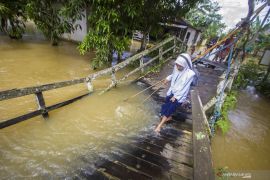Each area has designated locations for evacuee camps. During the COVID-19 pandemic, we follow health protocols in handling the impacts of disasters. Hence, we increase the number of evacuee camps.Jakarta (ANTARA) - The Indonesian government has increased the number of evacuee camps, especially in disaster-prone areas, as a precautionary measure against La Nina-induced hydrometeorological disasters.
"Each area has designated locations for evacuee camps. During the COVID-19 pandemic, we follow health protocols in handling the impacts of disasters. Hence, we increase the number of evacuee camps," Director General of Social Protection and Security of the Social Affairs Ministry Pepen Nazaruddin stated during an online press conference here on Tuesday.
In keeping with the set health protocols at evacuee camps, a cap is placed on the number of evacuees in tents to avoid crowding, and masks will be distributed among them, he noted.
Nazaruddin spoke of having held a coordination meeting with social service offices to prepare an inventory of disaster mitigation facilities and infrastructure, including public kitchens, tents, and quick response teams.
The meeting also discussed the preparedness of buffer stocks in each disaster-prone area, including logistics stocks at warehouses of the Social Affairs Ministry in Makassar, Palembang, and Bekasi.
The Meteorology, Climatology and Geophysics Agency (BMKG) had earlier warned of La Nina weather phenomenon of moderate intensity in the Pacific Ocean.
La Nina can potentially increase the amount of rainfall in most parts of Indonesia.
Indonesia, with monsoon and dry seasons, is prone to natural disasters, and usually some 75 percent of the disasters are hydrometeorological in nature, such as flooding, landslides, and strong winds.
The National Disaster Mitigation Agency (BNPB) reported that during the period from January to Oct 17 this year, Indonesia had recorded 2,276 natural disasters.
The hydrometeorological disasters comprised 827 floods, 637 whirlwinds, and 416 landslides.
The disasters affected 4.5 million people, with 307 individuals losing their lives, 25 persons going missing, and 469 people sustaining injuries. In addition, the disasters caused light, moderate, to serious damage to 35,176 houses and 1,481 public facilities. Related news: Indonesia braces for La Nina-induced hydrometeorological disasters
Related news: BMKG intensifies mitigation efforts over spike in natural disasters
Translator: Desi Purnamawati/Suharto
Editor: Rahmad Nasution
Copyright © ANTARA 2020












